The Irish Terrier has a lively character and is known as one of Ireland’s oldest dog breeds.
This breed is famous for its loyalty and devotion to its master, as well as its fondness for children, making them a popular household pet.
In fact, these versatile dogs are good all rounders.
While Irish Terriers were bred to be good hunters and steadfast guard dogs, these are also exceptionally friendly and affectionate with their families.
These highly intelligent, fearless dogs are high spirited and have a touch of divilment to them. It is hardly surprising that they are known as the “Daredevil” dogs.
My first introduction to Irish Terriers was through the disney movie “Lady and the Tramp”. I have been on the lookout for these loveable and charismatic dogs ever since!
This article may contain affiliate links. If you click on one of them, we might receive a small commission (at no extra cost to you). Thanks for your support to help us keep this site running!
Table of Contents
- 1 What is an Irish Terrier?
- 2 Fun Facts about the Irish Terrier
- 3 What are Irish Terriers known for?
- 4 Irish Terrier Breed Characteristics
- 5 Irish Terrier Maintenance
- 6 How long do Irish Terriers life for?
- 7 Are Irish Terriers healthy dogs?
- 8 What do Irish Terriers eat?
- 9 Irish Terrier Exercise needs
- 10 Irish Terrier Training
- 11 Irish Terriers Temperament and Personality
- 12 Are Irish Terriers rare?
- 13 Irish Terrier Clubs
- 14 Irish Terrier Puppies for Sale
- 15 The History of the Irish Terrier
- 16 Irish Terriers Today
- 17 Native Irish Dog Breeds
What is an Irish Terrier?
An Irish Terrier is one of four native Irish terrier dog breeds, the others being the Kerry Blue, Irish Wheaten Terrier and the Glen.
The other Irish dog breeds are:
- the enormous Irish Wolfhound
- the Kerry Beagle
- the Irish Setter
- the Irish Red and White Setter
- the Irish Water Spaniel
The Irish name for an Irish Terrier is Brocaire Rua.
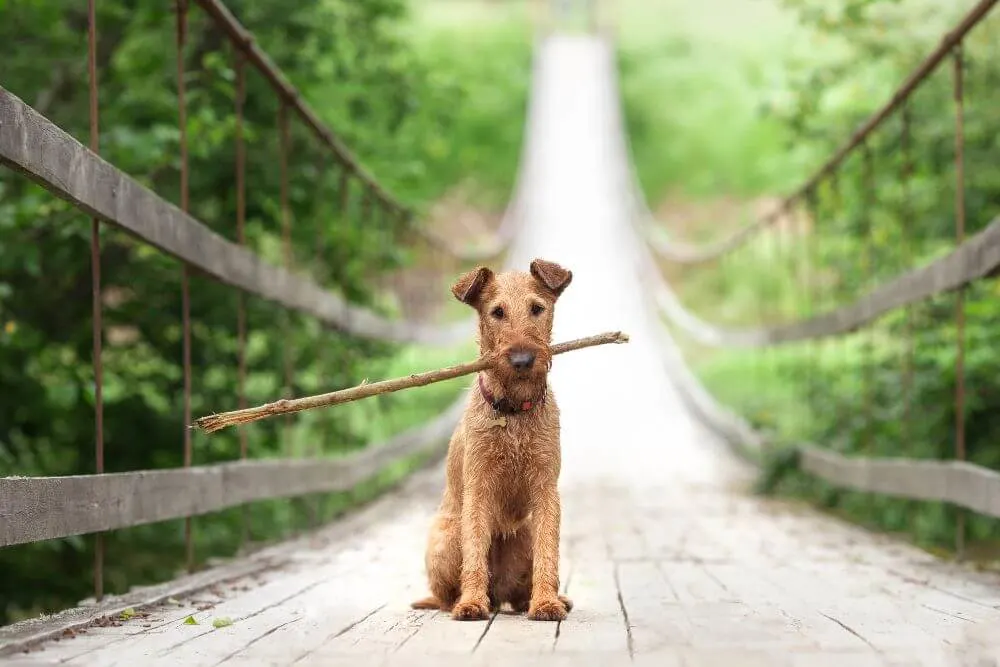
It is difficult to judge how long this breed has been in existence as there are no early records, but there are paintings illustrating the breed from at least the 17th century onwards.
Prior to the existence of the breed standard for the Irish Terrier, they came in a range of colors including black and tan, gray, brindle, wheaten, red wheaten and simply red. Today, the solid red Irish Terrier is the best known.
Fun Facts about the Irish Terrier
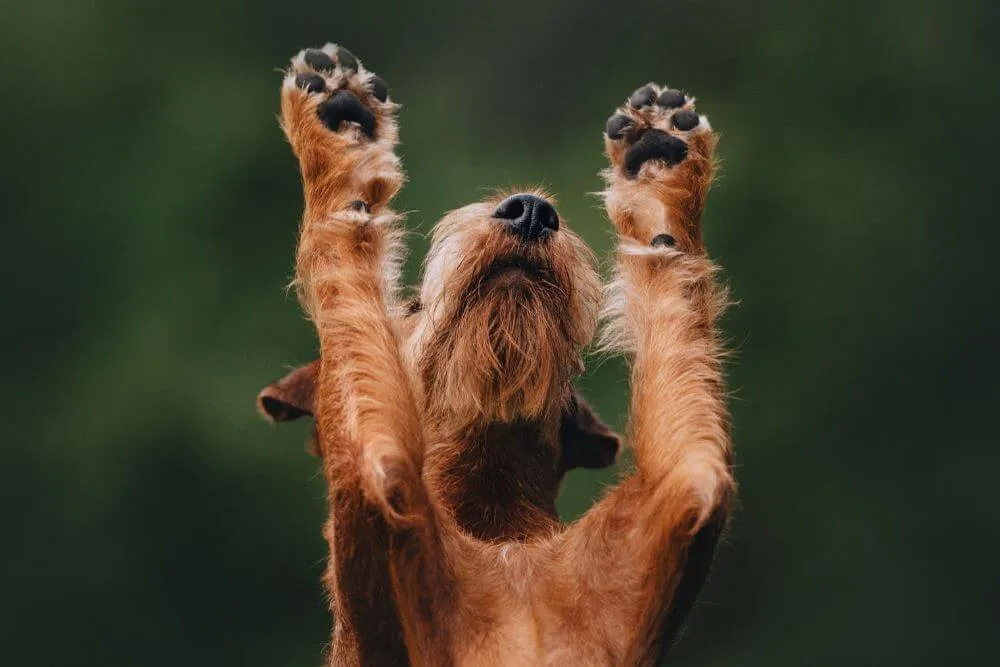
- First Irish terriers to be recognised as a breed and first regognized native Irish breed of dog
- Irish Terriers were used extensively in World War I as messenger dogs and sentinels.
- Famously loyal with one report of an Irish Terrier who turned up at his master’s side on the battlefield in France in WWI after somehow finding his own way there from London. (More details below)
- In the 1955 Disney movie “Lady in the Tramp”, the character of Tramp is based on an Irish Terrier
- Fire, animation and a “devil-may-care” attitude are very important features of this breed
What are Irish Terriers known for?
Irish Terriers are known for their fiery, bright red coats and their strong-willed nature combined with a bold adventurous spirit.
They are incredibly loyal and brave protectors of their owner and family.
Yet despite this fearlessness, there is a very gentle affectionate side to these dogs too making them good playmates for children.
They are also incredibly good at catching vermin, which is what they were initially bred to do, like other breeds (such as ther Rat Terrier and the American Hairless Terrier).
As they have a highly developed sense of alertness and naturally wary of strangers, they also make good guard dogs.
Irish Terrier Breed Characteristics
How tall is an Irish Terrier?
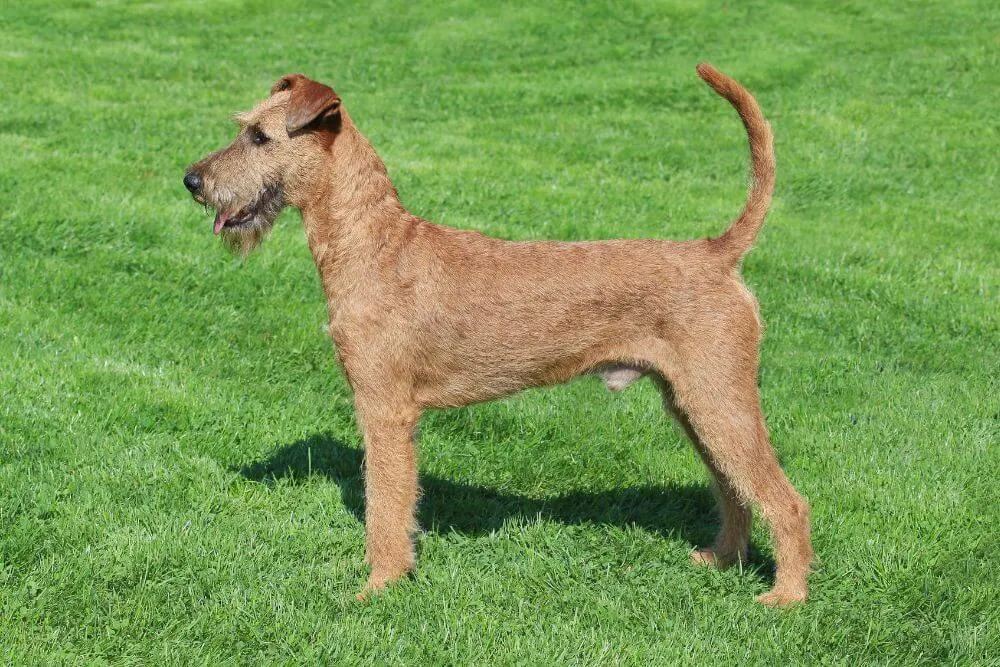
The Irish Terrier is a medium-sized dog roughly about 45 cm or 18 inches in height to the withers with the males and females being relatively similar in size.
Interestingly, size is not the most deciding factor when it comes to Irish Terrier show dogs. Irish Terrier size is something that is often debated.
While the measurement of about 45 cm (18 inches) is seen as most desirable, many show dogs are slightly taller than this today.
The overall proportion, symmetry and balance of the dog is more important when judging Irish Terriers.
How much does an Irish Terrier weigh?
Irish Terrier weight is typically about 13 kg (28 pounds) for females and 15 kg (33 pounds) for males.
As the dogs are often bigger than the breed standard desired 45 cm (18 inches), the animals are very frequently heavier than the 11-12 kg (24-26 pounds) outlined in the standard.
What does an Irish Terrier look like?
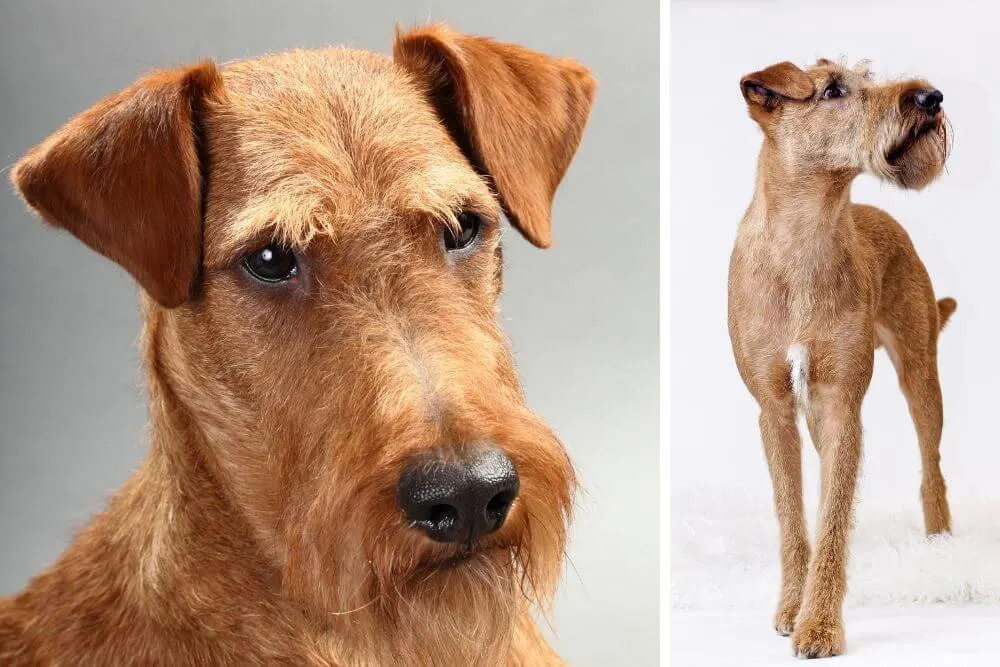
Irish Terriers are known for their well balanced proportions and symmetry.
They have a graceful outline that is neither cobby or cloddy, which means that their bodies should not be short or compacted (cobby) or be low set and heavy in appearance (cloddy).
These dogs are medium sized and have a medium-length double coat and long straight legs.
Their long head has a flat skull with expressive dark brown eyes that are small in size and deep-set.
The ears are set above the height of the skull and fold forward rather than dropping like a hound.
Dogs should have well laid back shoulders that don’t slack, a straight topline and a high set tail.
The back of this breed should not be short, like that seen in other terriers (like the Fox Terrier).
Their chests are deep and muscular, but not particularly wide.
The lithe physique of Irish Terriers is built for speed and the way that the animal holds itself should convey a sense of fire and animation. (
How exactly to define Irish Terrier spirit is a challenge, but once you have seen it, you’ll know.)
The dogs have a “devil-may-care” attitude. This agile dog is not clumsy in its actions.
Irish Terrier Coat
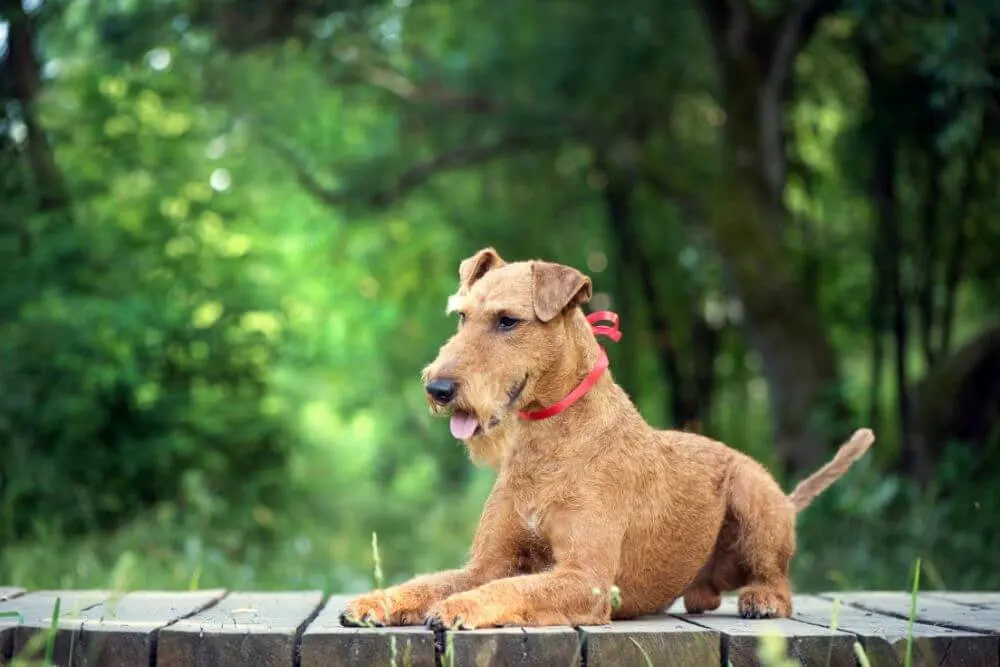
The double coat of the Irish Terrier comes in a few colors, not just the typical red Terrier coat.
(Before the breed was standardized, the coat was not a particularly important feature. In Ireland terriers were primarily seen as working dogs up until the latter 19th century.)
The coat colors could have been black and tan, gray, wheaten or red.
Irish Terrier black and tan color dogs still appeared in some litters around the beginning of the 20th century, but they were not used to breed and Irish Terrier colors of the solid red, wheaten or wheaten red became prominent.
The Irish Terrier white patch occasionally seen on the chest is not a disqualifying feature for show dogs.
Irish Terriers have a wiry, medium length overcoat and a soft, light colored undercoat.
Irish Terrier Ears
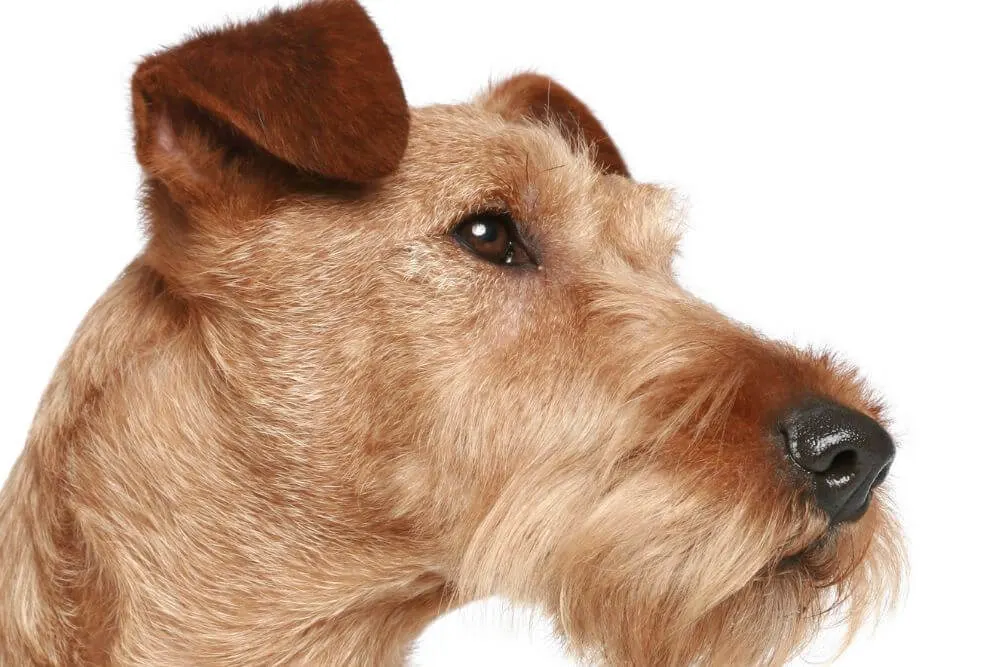
Irish Terrier ears are v-shaped and are small, moderately thick and have hair that is darker than on the body.
The Breed standard says that the ears should drop forward towards the cheeks.
To get this appearance, the ears of show dogs are sometimes glued around the 1 year mark for 6-8 months so that they can be “trained” into position.
In the 19th century, the ears of Irish Terriers were cropped.
However, soon after the formation of the Irish Terrier Club in 1879, this practice was banned for this breed and soon after outlawed for all breeds in the British Kennel Club.
What do Irish Terrier puppies look like?
Irish Terrier puppies often have black highlights in their coats when they are born, however, these black Irish Terrier hairs disappear as they get older.
Up until the beginning of the 20th century, many puppies were born with black and tan coats, but selective breeding has eliminated this color from the coats at this stage.
The Irish Terrier puppy can often have a bit of a gangly appearance as a long-legged terrier, but this disappears as they mature into the more balanced and symmetrical form the adult dogs of this breed is famous for.
You should take this into consideration if your are trying to find the right name for your pet!
What age are Irish Terriers fully grown?
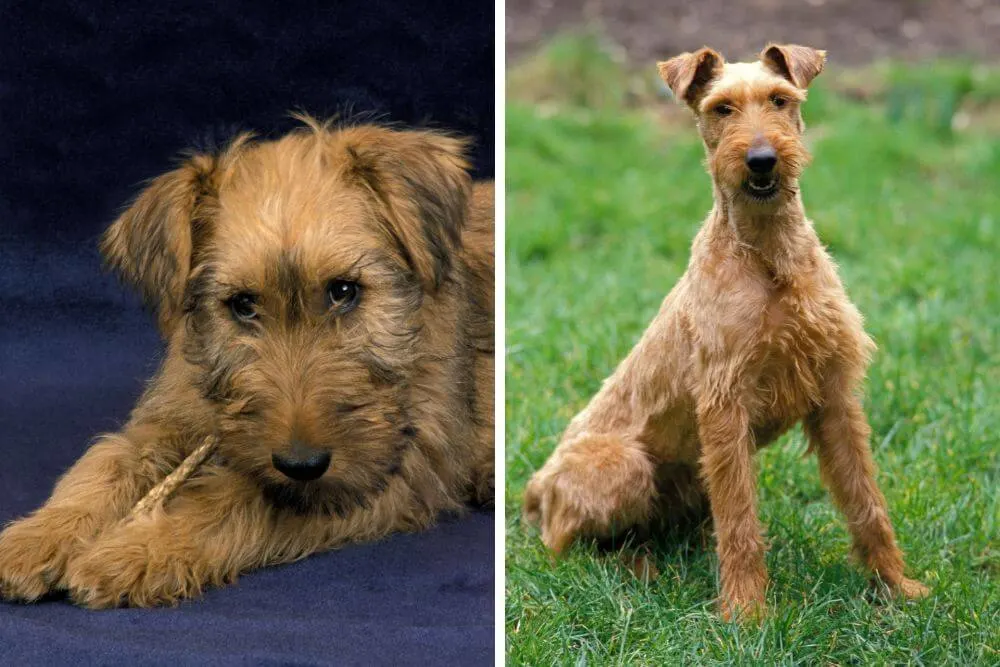
It takes roughly about 14 months for Irish Terriers to reach their full grown size which is approximately 45 cm or 18 inches.
Irish Terrier Maintenance
Irish Terriers are not particularly high maintenance. Nails must be regularly cut and regular dental care is also important.
They need regular brushing and their coats can be trimmed occasionally to keep them tidy. As they tend not to lose that much hair, the dead hair and other debris should be removed by stripping.
Do the Irish Terriers need much grooming?
The wiry double coat of the Irish Terrier needs regular grooming to stay in good condition.
A thorough brushing once a week usually suffices, plus hand stripping about three times a year to remove dead hair.
This is roughly the same amount of maintenance that you would expect with other somewhat similar dog breeds, such as the Smooth Fox Terrier or a Miniature Bull Terrier.
Do Irish Terriers shed hair?
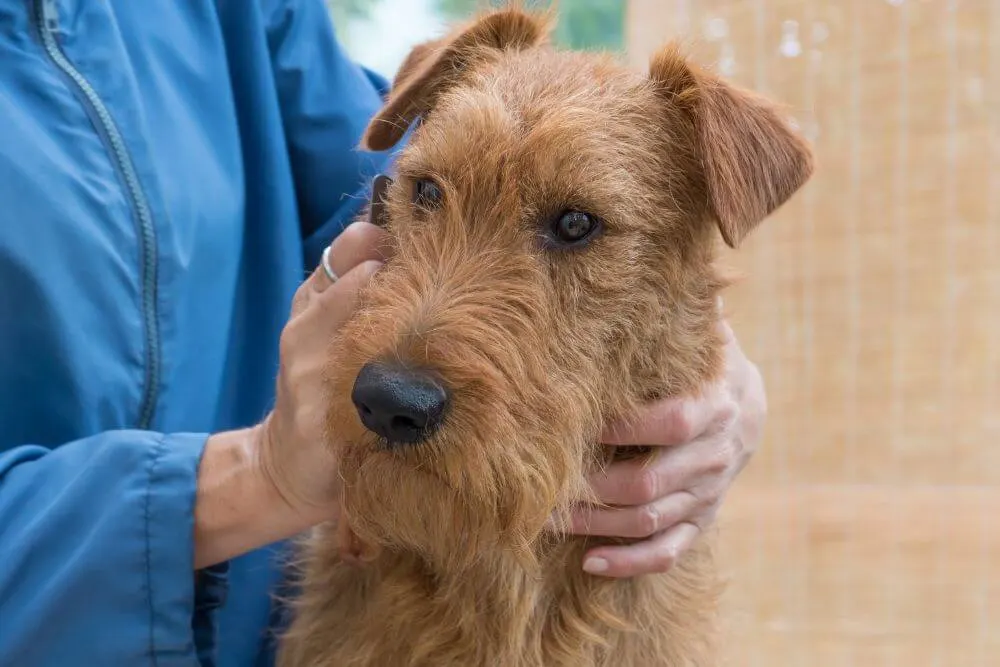
Irish Terrier shedding (or drooling for that matter) is not really an issue. In fact, Irish Terriers tend to shed very little hair from their thick double coats.
To ensure that the dead hair is removed it is necessary to strip the dog either by hand or using a blunt stripping knife.
How often should you hand strip an Irish Terrier?
Each year, an Irish Terrier should be stripped about three times.
This is a slow, and time consuming process but it can help to strengthen the bond with your dog. Ideally this form of grooming should begin from an early age (roughly 6 months) so that the dog can become accustomed to it.
Is an Irish Terrier hypoallergenic?
Irish Terriers are considered to be hypoallergenic as they tend to shed very little and produce less dander than other similar breeds.
Many people who do have mild allergies have noted that the symptoms are not very strong around Irish Terrier dogs (or in some cases not present at all).
(Always check with a specialist before considering what breed could be best suited to you if you have allergies!)
How often should you bathe an Irish Terrier?
It is only necessary to give an Irish Terrier a bath 2-3 times a year (or when it is really absolutely necessary). Excessive bathing can remove the natural oils from the dog’s skin and hair and leave it dry.
How long do Irish Terriers life for?
On average, the Irish Terrier lifespan is 12-16 years. Most Irish Terriers live to be about 13-14 years of age.
Are Irish Terriers healthy dogs?
Generally speaking, yes Irish Terriers are healthy dogs, but they do tend to suffer from some minor health problems, which are bladder and kidney stones (cystinuria), cataracts, thyroid problems and hereditary footpad hyperkeratosis (caused hard cracked footpads) was more of an issue in the 1960s and 1970s in this breed.
Hip dysplasia tends to occur seldomly in Irish Terriers.
Before you consider getting an Irish Terrier, it is important to ask reputable breeders and vets about these common health problems.
What do Irish Terriers eat?
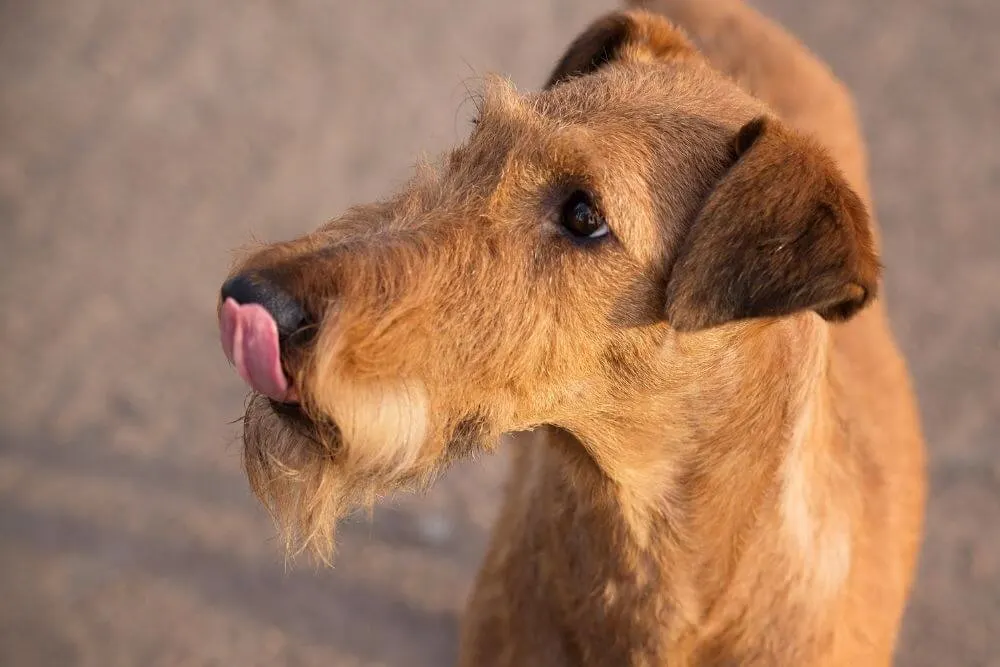
Irish Terriers need a healthy diet of high-quality dog food, which can be either made of dry or wet food.
Generally, adult Irish Terriers are not that fussy when it comes to what they eat, however it is important to ensure that they get the right amount of easy to digest protein in their diets.
Luckily, Irish Terriers do not typically have many food allergies.
One thing to note is that Irish Terriers do occasionally suffer from bladder and kidney stones (cystinuria), so it is advisable to feed animal proteins that are easily digested to avoid placing extra stress on the kidneys.
The dogs need to have easy access to plenty of fresh, clean water as well.
Make sure you consult with your veterinary specialist to ensure that your dog is getting the right type and amount of food to suit their age and activity requirements, to ensure that the animal does not put on too much weight.
Irish Terrier Exercise needs
How much exercise does an Irish Terrier need?
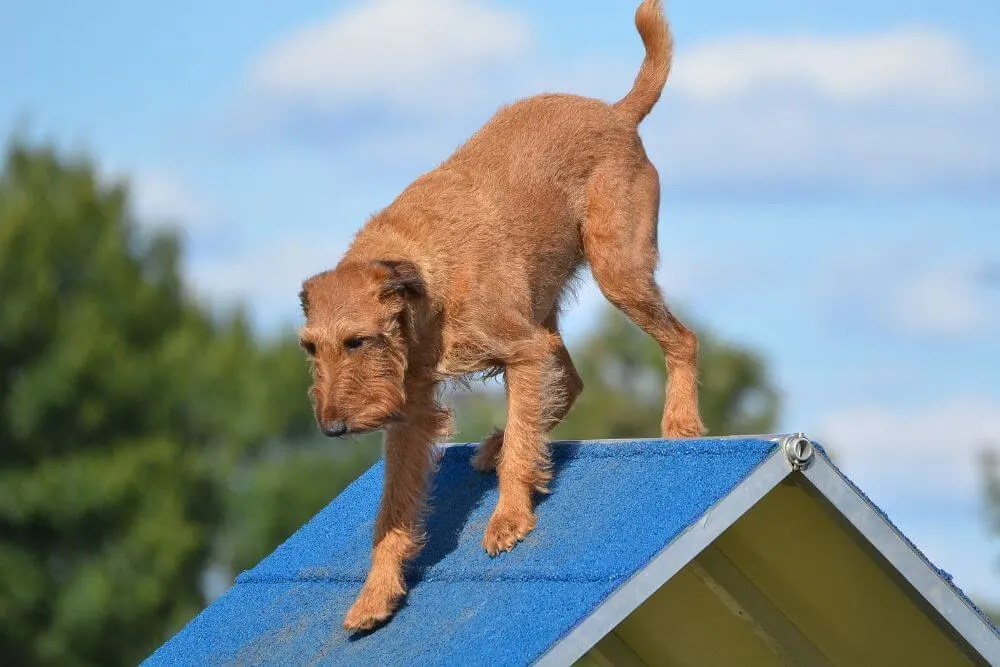
Packed with lots of energy, these lively dogs need a moderate amount of exercise every day (at least one hour) to keep them in top shape, both physically and mentally.
A combination of brisk walks, as well as letting them run free in a fenced area works best.
It is also great to add a bit of variety to the routine.
These terriers need exercise, but it can involve a range of sports. Luckily, Irish Terriers are typically happy to take part in mountain hiking, sled pulling, boating and even skateboarding activities.
It is also important to ensure that these smart dogs are mentally stimulated.
Canine sports including agility trials, flyball and rally obedience trials are a great way to engage these smart, talented, athletic dogs.
Are Irish Terriers good off leash?
Irish Terriers have a strong prey instinct, so it is advisable to always have the dog on a leash in a public space.
The sight of a squirrel, deer, cat or small animal is likely to ignite that natural instinct and the dog is likely to give chase, in the process ignoring all of your calls.
The dogs certainly enjoy the freedom to run around without a leash, but best to do this in a fenced area, away from small animals and other potential game.
Consisting training can help to improve this behavior in Irish Terriers.
Do Irish Terriers like to swim?
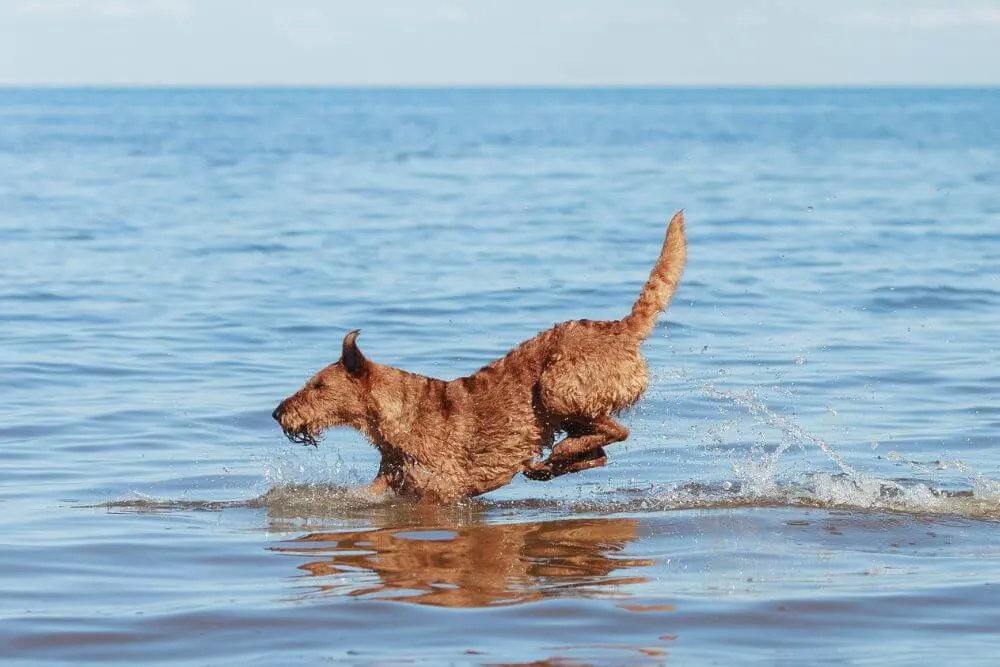
Yes, Irish Terriers love to swim and it is a great form of exercise for them. Early introduction to water is the key to ensure that the dog is familiar with and enjoys being in this element.
Irish Terrier Training
Irish Terriers respond well to training given the right circumstances and owner.
These independent, willful dogs can be a bit of a challenge, so it is important to start training early from about 8 weeks with an owner who is a strong responsible leader with an authoritative, calm and firm training manner.
The owner also needs to have a lot of patience to continually reinforce the dog training in order to be successful.
Consistency and positive reinforcement are the keys to training this breed and will help to ensure that this dog is well behaved and balanced.
As highly intelligent dogs they can learn and adapt quickly. Their slightly mischievous or bold nature means that proper training is essential if you want a well behaved, calm dog.
Is an Irish Terrier a good first dog?
Irish Terriers are loving, energetic and intelligent dogs, but they are also stubborn and headstrong at times with a penchant for mischief-making that can make them a handful.
To determine if the Irish Terrier is a good first dog for you, you will need to assess if you are the right owner for the dog and its personality.
As one of the more feisty, lively breeds Irish Terriers may not suit everyone.
Owners need to be clear and consistent with training, as this breed responds best when there is a clear alpha.
This can be a big challenge and can be too much if you have not had any previous dog training experience.
Irish Terrier Dog Sports
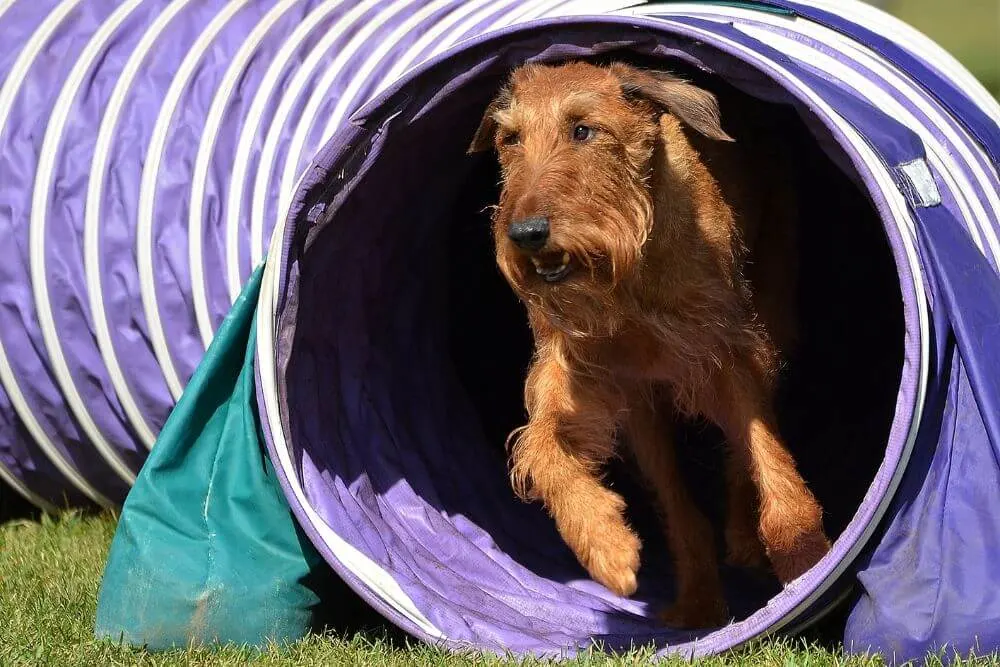
Irish Terriers are enthusiastic participants in a wide range of sports and are extremely versatile.
Their natural athleticism, impressive learning skills and willingness to please make them highly suitable competitors in agility, rally, obedience and flyball for example.
Irish Terriers Temperament and Personality
For centuries, the Irish Terrier was a multi-tasking farm dog that needed to be well suited and tolerant to family life, but more importantly be useful on the farm to earn its keep in rural Ireland.
These loyal dogs are devoted to their owner and will protect them fearlessly when called upon to do so.
As farm dogs they would have regularly been used to protect livestock from threats. Irish Terriers operate well when given tasks and need a high degree of mental stimulation.
Irish Terriers are also extremely tolerant of children and are willing to accept a fair degree of rough and tumble play with them in a good natured way.
When it comes to strangers, Irish Terriers do not tend to warm to them straight away and are wary. This trait makes them useful guard dogs.
To avoid issues, it is always good to start training your dog early and introducing them to new people, (as well as dogs and other animals) early on.
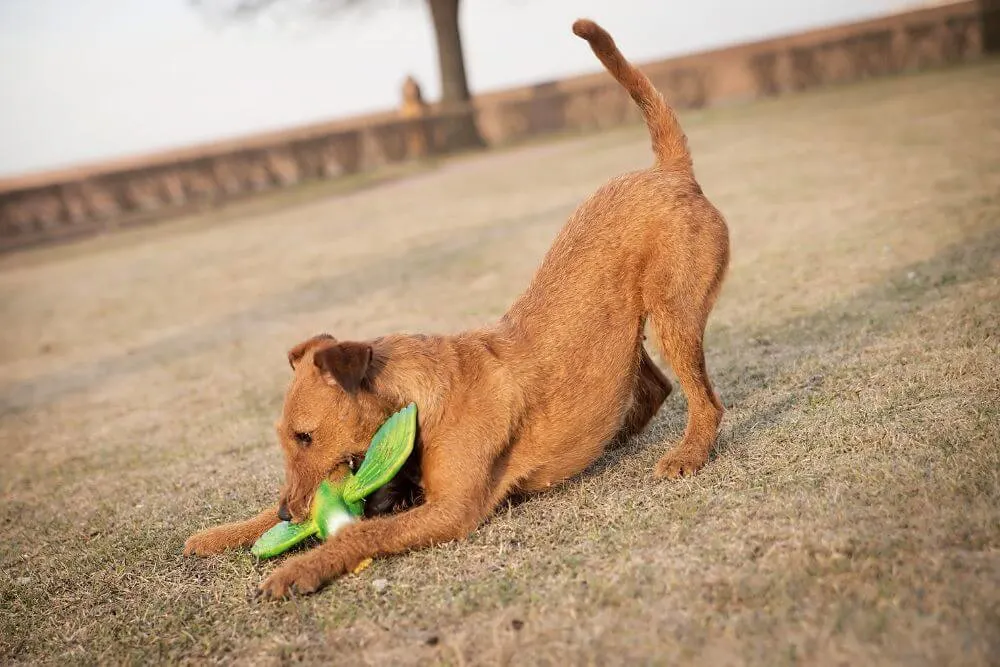
Do Irish Terriers bark a lot?
Irish Terriers bark at a pretty average level. While they certainly bark a lot, they usually need a trigger for them to start them.
As very alert dogs, they will bark for your attention when there is a stranger around and make very good guard dogs.
If they are not trained at a young age, they may tend to bark more.
Can you leave Irish Terriers alone?
As Irish Terriers do not usually suffer badly from separation anxiety, it is ok to leave them alone for a few short hours.
This is based on the premise that they get the sufficient exercise and proper attention that they need at some other stage in the day.
Without the proper outlet for their high energy levels, the dog is likely to become bored and more mischievous.
Are Irish Terriers good with children?
Irish Terriers are known for being well-liked family dogs and are very good with children.
They make compliant, gentle playmates who are loving and affectionate.
As this breed has plenty of energy, games that the dog and children can play together like fetch and frisbee can lead to hours of fun!
While usually Irish Terriers love children, it is always best to always make sure that dogs and children are supervised when together.
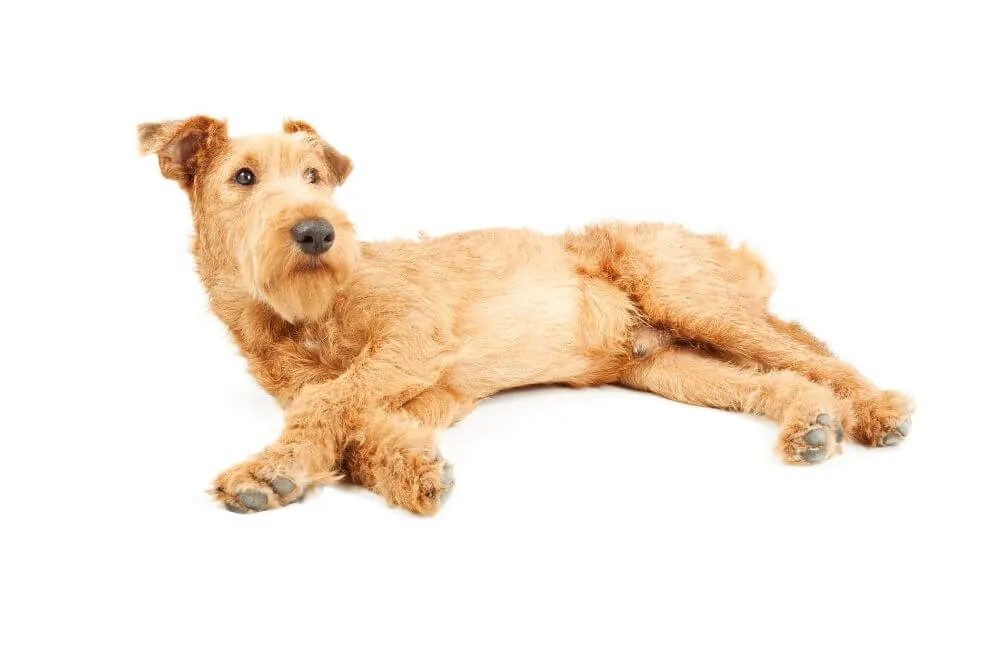
Do Irish Terriers make good service dogs?
Irish Terriers are obedient, intelligent and loving towards their direct family.
They are task oriented, enjoy mentally stimulating tasks and are happy to please their owners.
Once Irish Terriers are properly trained and socialized, they can make very good service dogs. Without proper training, it is likely that these dogs are too willful and headstrong.
Do Irish Terriers like to cuddle?
Once the dog receives enough active exercise each day, a well balanced Irish Terrier dog will happily curl up at your feet or cuddle on the sofa at home.
They are very warm hearted to those who they know and enjoy company.
Are Irish Terriers good with other dogs?
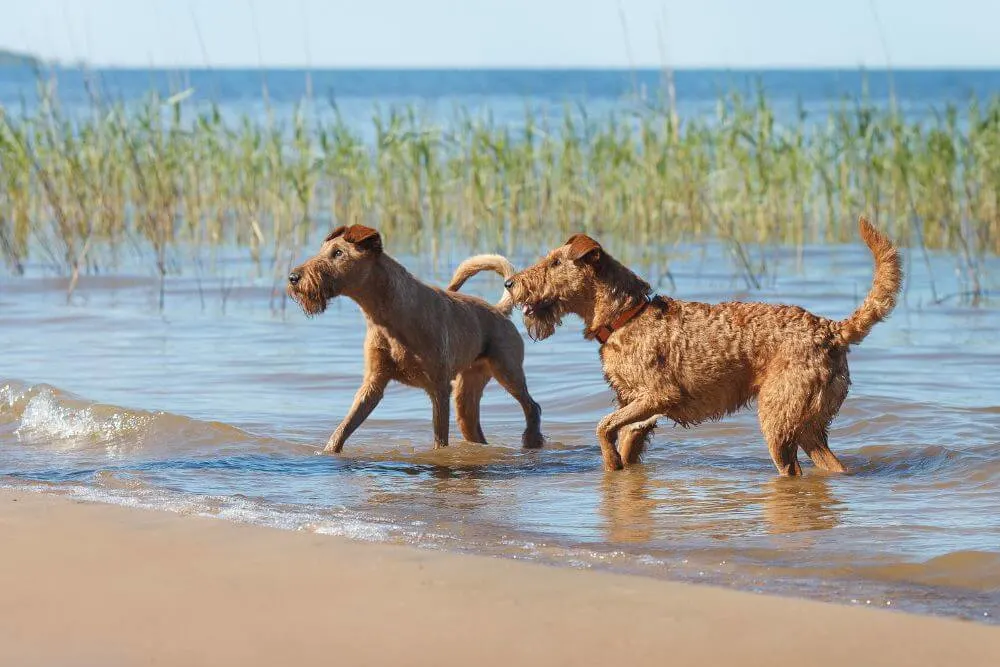
In general Irish Terriers do not tend to mix well with other dogs and can be aggressive when put together with dogs of the same sex.
Under some conditions, they can also be with other dogs, but early socialization, a well established pack and a dominant owner are essential to making this work.
“Sparring”, is used during the proper selection process in dog shows to judge Irish Terrier temperament.
It involves two Irish Terriers of the same sex being “shown” to each other at a slight distance and judges then assess their response to stand their ground and alertness for a potential threat.
Are Irish Terriers aggressive?
Irish Terriers are not typically aggressive to their owner or their children, but as very protective and territorial terriers, they can be aggressive towards other dogs, particularly those of the same sex.
This breed will also bark and growl at strangers and be naturally wary of them.
The hunting instinct in this breed is still strong, so small animals are natural targets for this expert vermin hunter.
Cats, ferrets and other similar sized household pets are all potential game for this breed with a high prey drive, so best to keep them apart.
Are Irish Terriers rare?
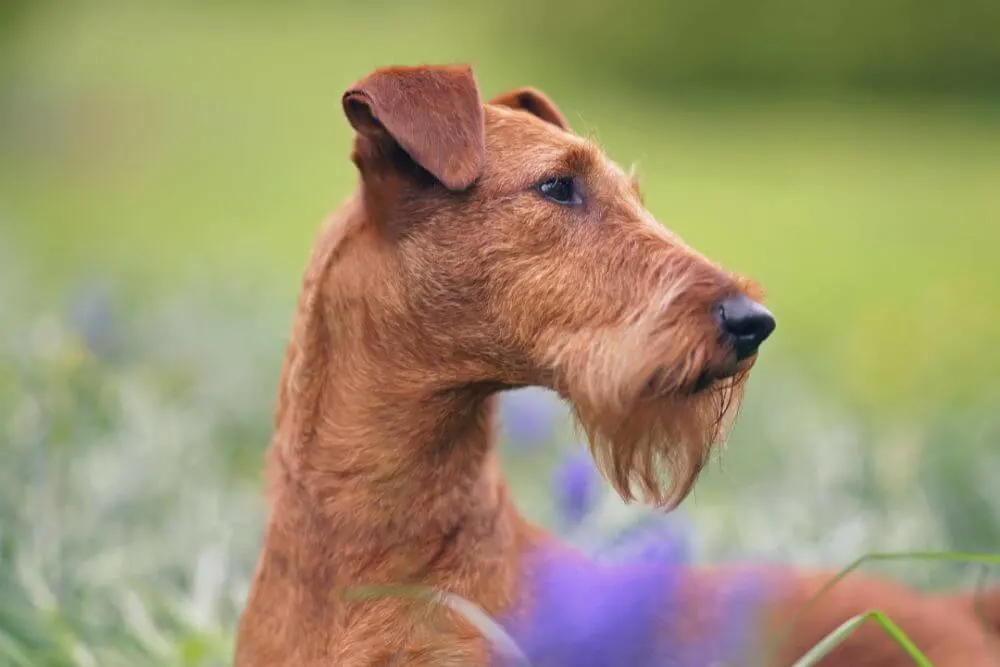
Irish Terriers are considered a vulnerable native Irish breed, with less than 300 registrations to the Irish Kennel Club per year.
The popularity of this breed is somewhat increasing, particularly in the UK and the United States due to the breed’s suitability as a family dog, but numbers still remain low and there are not many reputable breeders.
Irish Terrier Clubs
Irish Terrier breed clubs are found all over the world. Fanciers for the dog breed Irish Terrier invest large amounts of time and effort to promote the breed and ensure it continues to bring joy to people’s lives well into the future.
Here are some Irish Terrier Clubs:
- Irish Terrier Club of America
- Irish Terrier Association (UK)
- All Ireland Irish Terrier Club
- Förderverein Irish Terrier (Germany – this article is also available in German)
- Suomen Irlanninterrierit (Finland)
- Nederlandse Ierse Terriër Club (Netherlands)
Irish Terrier Puppies for Sale
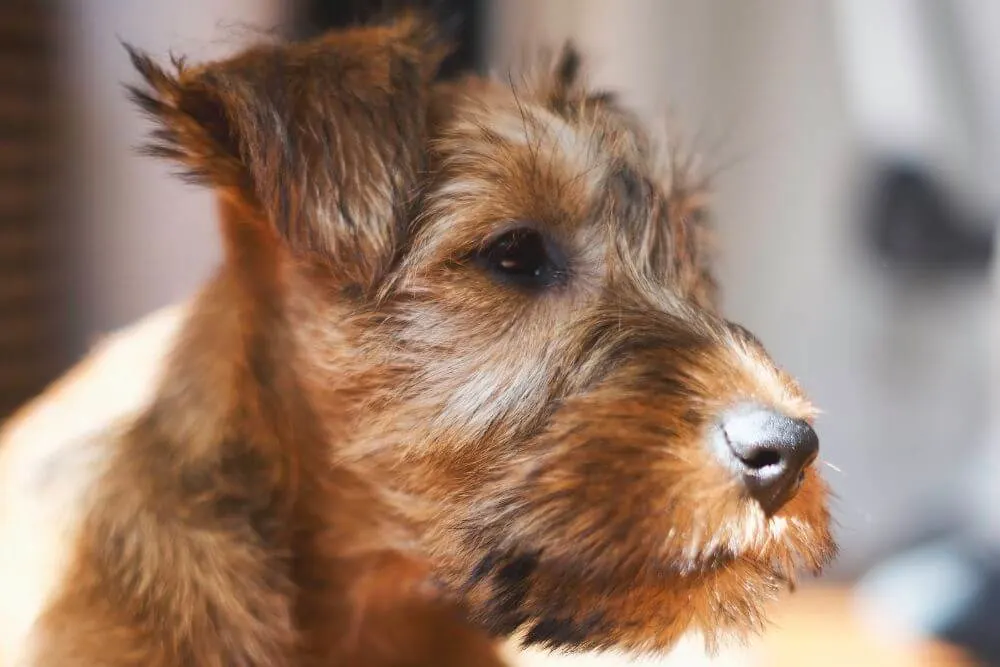
It is important to always buy puppies from reputable breeders who are willing and happy to share all of the information you need, such as the health of the parents and the temperment of the dog.
Irish Terrier Breeders
For those of you searching for an Irish Terrier for sale in the United States, it is best to follow the breeder contacts on the American Kennel Club website.
Breeder contacts for Irish Terriers for sale in Canada can be found on the Canadian Kennel Club. In Ireland, the contacts for Irish dog breeders can be found via the Irish Kennel Club.
In the UK, Irish Terrier puppies for sale are listed on the Kennel Club website. The long running Irish Terrier Association in the UK, which was first established in 1911, is also a knowledgeable source of information about Irish Terrier breeders and rescue dogs.
Bonus Tip: Don’t forget to check with your local veterinary clinic too as they may be able to direct you to known breeders.
Irish Terrier Puppy Price
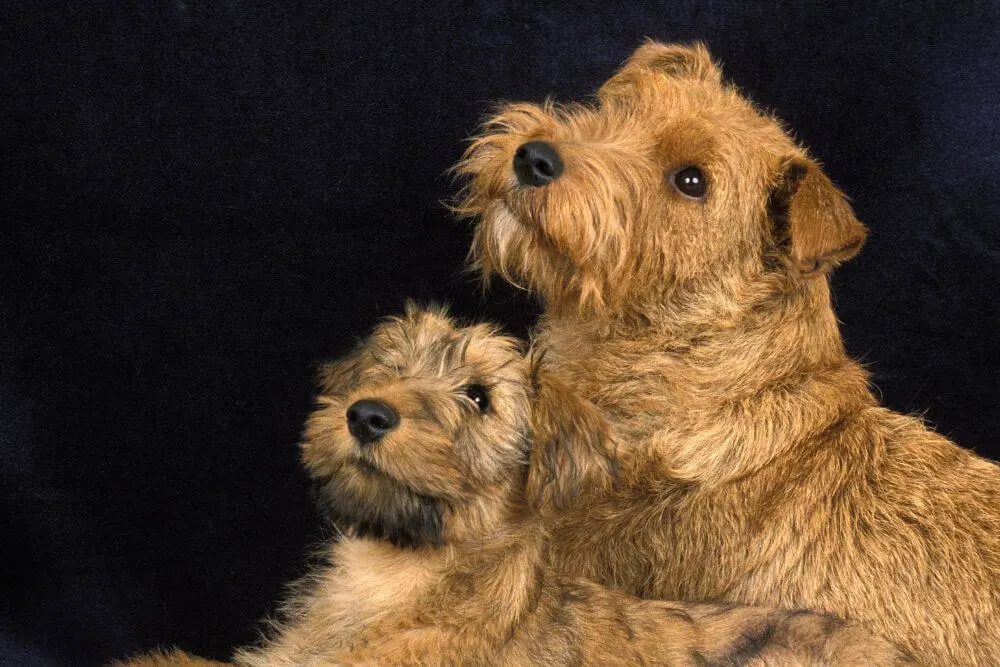
The price of an Irish Terrier puppy varies quite a bit. Several different factors impact the price of a dog, such as the location, whether the puppy is male or female, whether the dog is a show dog or a pet, or whether there have been any champions in the bloodline.
As this is also a rare breed, availability can also be an issue.
As a rough guide, an Irish Terrier puppy costs roughly US$1500-$US3500. Be prepared to also be put on a waiting list for your dog.
Adoption is a cheaper option, but new owners are usually asked to make a donation and cover all the costs related to paperwork.
Bonus Tip: Are you looking for the perfect name for your dog? We have a superb selection of very fitting Irish girl dog names and Irish boy dog names.
Irish Terriers in Need and Irish Terrier Adoption
Changes in family circumstances mean that sometimes Irish Terriers may need to be rehomed. In other cases, perhaps the dog and the owner were not well matched, either way Irish Terrier rescue dogs occasionally become available for adoption.
Adopting a rescue dog can be a very fulfilling experience with many benefits. The Irish Terrier Association in the UK offers some useful information about this here.
The History of the Irish Terrier
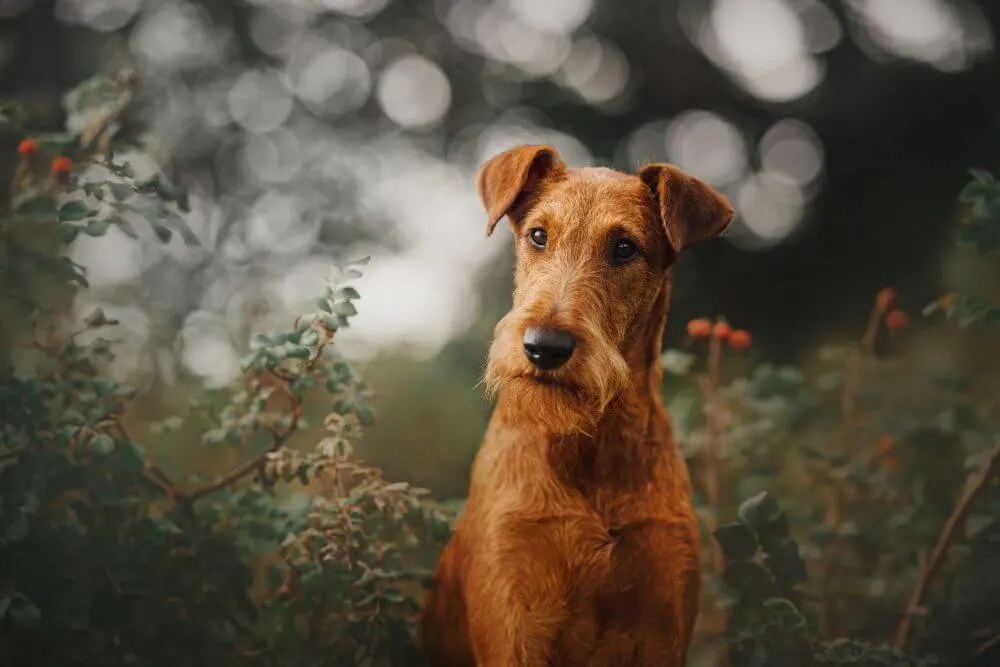
Irish Terriers come from somewhat uncertain origins in Ireland.
Their history since they became more widely known in about the 1880s has been an interesting one that includes their rapid rise and subsequent fall in popularity, standardization of coat color and involvement in World War I.
Irish Terrier Origin
As with many Irish breeds, their exact origins are unknown and stretch back to a time when breeding records for working dogs did not exist as we know them today.
It is clear that the Irish Terrier is an old breed and depictions of this breed have been shown in images that date back to the 1700s.
One of the earliest known references to the breed is from Richard Ridgeway, the founder of the Irish Terrier Club, who stated that the Irish Terrier was a purebred from around the early 1800s.
One thing is clear that the Irish Terrier appealed to people of different classes and the breed is famously described as being “the poor man’s sentinel, the farmer’s friend and the gentleman’s favorite”.
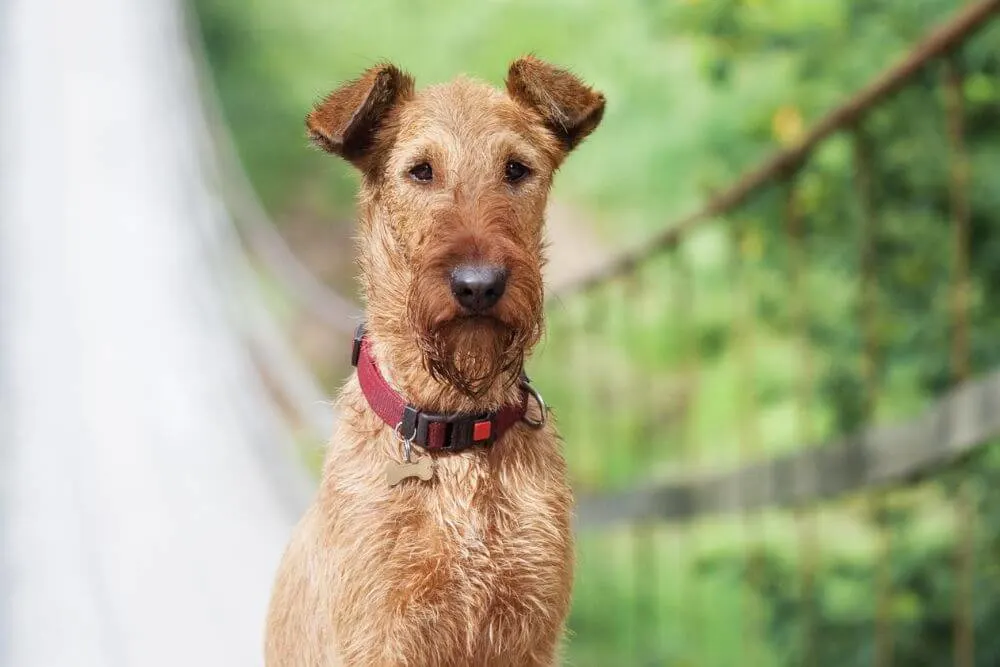
Where is the Irish Terrier from?
There is some speculation that the Irish Terrier is from County Cork in the south of Ireland. Certainly there were a lot of Irish Terriers from this region, but some of which were thought to be more wheathen in color.
It is thought that another strain of Irish Terrier that was found in County Antrim bears more of a resemblance to the Irish Terrier that we are familiar with today.
Irish Terrier Working Dog
An Irish Terrier was bred for its ability as a hunter and adaptable farm dog. Known for its expert skill as a ratter and vermin hunter, these dogs would have been used to eradicate rodents from buildings and catch other small game.
They would have also been used to help hunters to flush out other game such as birds and waterfowl. This all rounder also acted as a retriever for game on both land and water.
Irish Terrier Breed Recognition and Irish Terrier Show Dogs
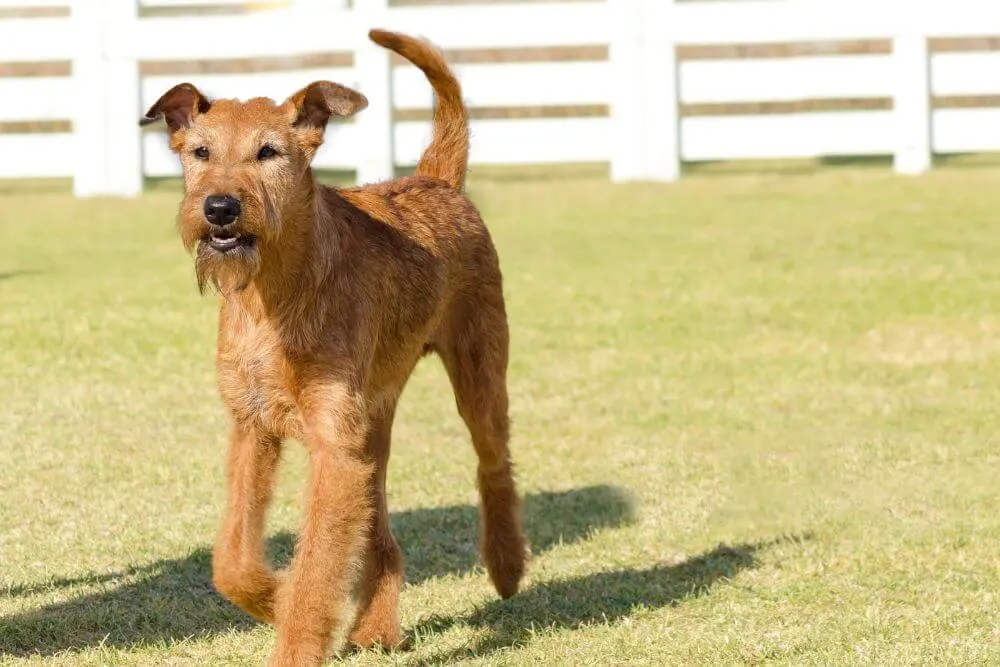
The breed was first shown in 1873 at a Dog Show in Dublin. At the time, the breed was far from standardized with two weight classes offered (over and under 9 pounds or 4 kg). This helped to trigger interest in the breed.
The Irish Terrier became the first Irish terrier breed, as well as being the first native Irish breed of dog to be recognised.
Records suggest that the first time this breed was properly recognised was at a Dog Show in Glasgow, Scotland in 1875.
The American Kennel Club followed this by recognizing the breed a few years later in 1885.
By 1879 the Irish Terrier Club was founded in Dublin. Soon afterwards, many of the offspring of the bitch “Erin” and the sire “Killiney Boy” became show champions and the dogs became more well known on the international stage.
The Irish Terrier Irish and British people kept as pets became more and more popular as the 1880s progressed.
These dashing dogs were held in such high esteem that they were also gifted as prized presents to royalty and important individuals throughout the British Empire.
Did you know?
Jack, the dog Irish Terrier belonging to King Edward VII only lived a few short hours on Irish soil before unexpectedly dying in 1903.
If you happen to be in the grounds of the Irish President’s House at Áras an Uachtaráin in the Phoenix Park, Dublin there is a single gravestone dedicated to his memory.
Irish Terrier and World War I
The smart and obedient nature of the Irish Terrier has also caught the eye of the military. This particular breed was the breed of choice when it came to conscripting roughly 20,000 dogs into the Allied Forces in World War I.
Irish Terriers took on the roles of messenger carriers to the troops on the front lines during the war. Trained to be quiet and quick, these dogs delivered key communications and saved the lives of countless soldiers.
As the dogs were faster and less visible than soldiers, they were ideal at their task.
Their great sense of smell also helped to detect where enemy troops were and alert the Allied Forces.
In addition, their original hunting skill set also came in very useful as these dogs took on the role of rodent control in the many rat infested trenches.
The presence of Irish Terriers war heroes among the soldiers was also a welcomed distraction from the misery of war and they were well liked comrades.
The Irish Terrier of the North Staffordshire Regiment
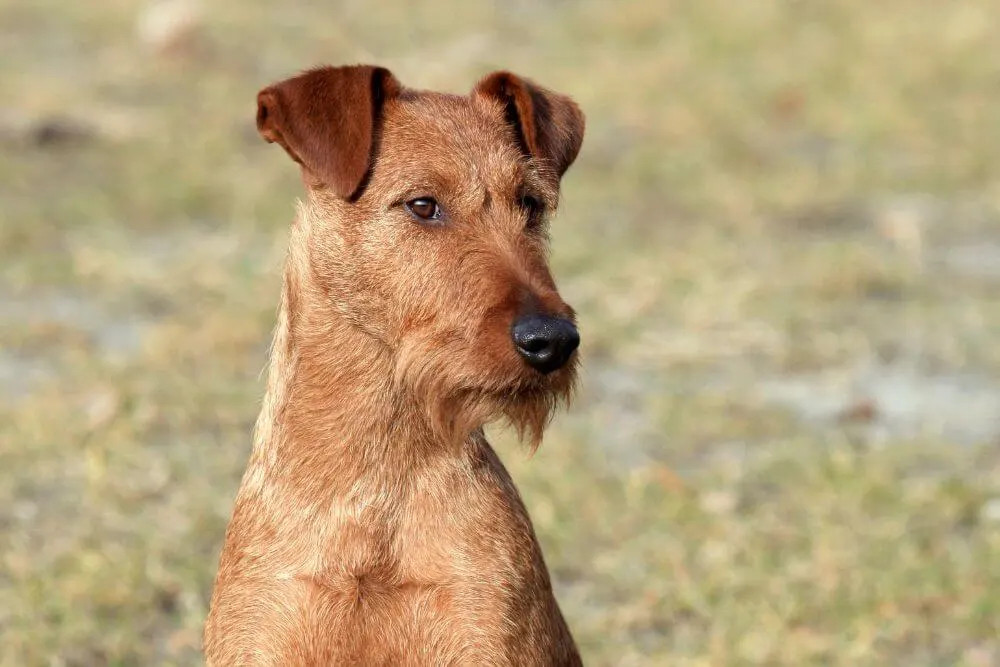
When news broke of a far fetched, but apparently true story of a Irish Terrier mix named Prince from Buttavant in County Cork managing to find his owner Private James Brown in France, it made national headlines in 1914.
Many Irish men fought for the British in World War I. Private Brown was part of the North Staffordshire Regimentleft.
When he departed with his regiment, his wife traveled to London with their dog, Prince. Shortly afterwards Prince went missing and somehow managed to find his way from London to Armentieres in France, where Brown and the North Staffordshire Regiment was stationed.
The good news is they both survived the war, if you would like to read more, you’ll find more about the fascinating tale here.
Irish Terrier after World War I
In Britain, these dogs were initially seen as war heros directly after the war had ended and there was an increase in the popularity of the breed. This was short lived though as with many things associated with the war, they quickly fell out of favor.
Ireland was a very politically sensitive place after the end of World War I as it fought for independence from Britain. As the Irish Terriers had strong connections with the British Forces, the dog breeds Irish people preferred changed.
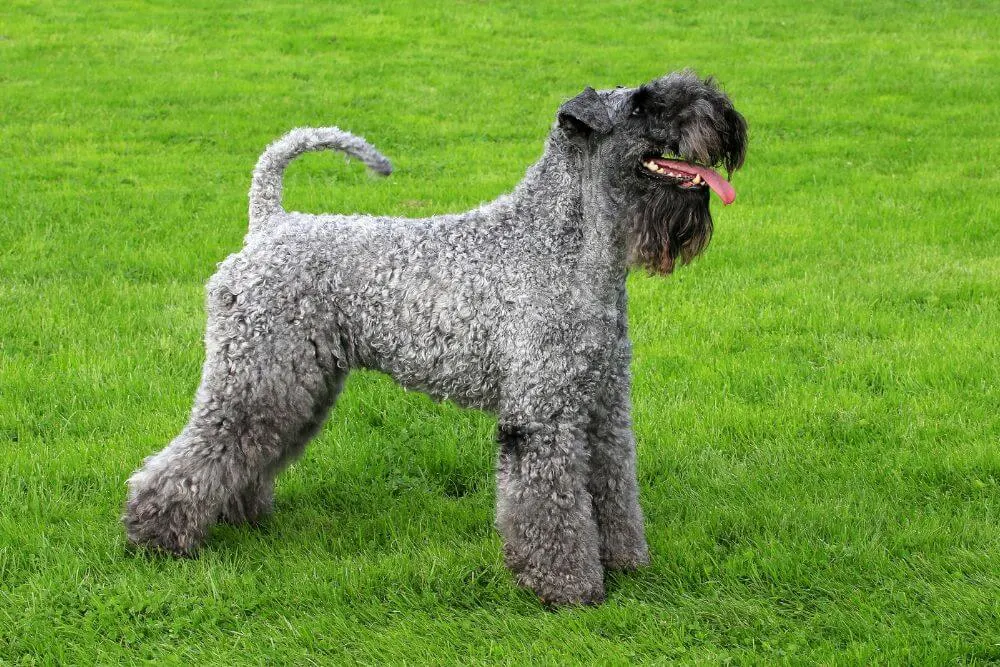
In comparison, another Irish terrier, the Kerry Blue Terrier, which was a favorite of the Irish National Leader, Michael Collins, started to become a more popular dog in Ireland. Known for its courage and intelligence, this breed, which had no real connection with British gentry, became a firm favorite.
Irish Terriers Today
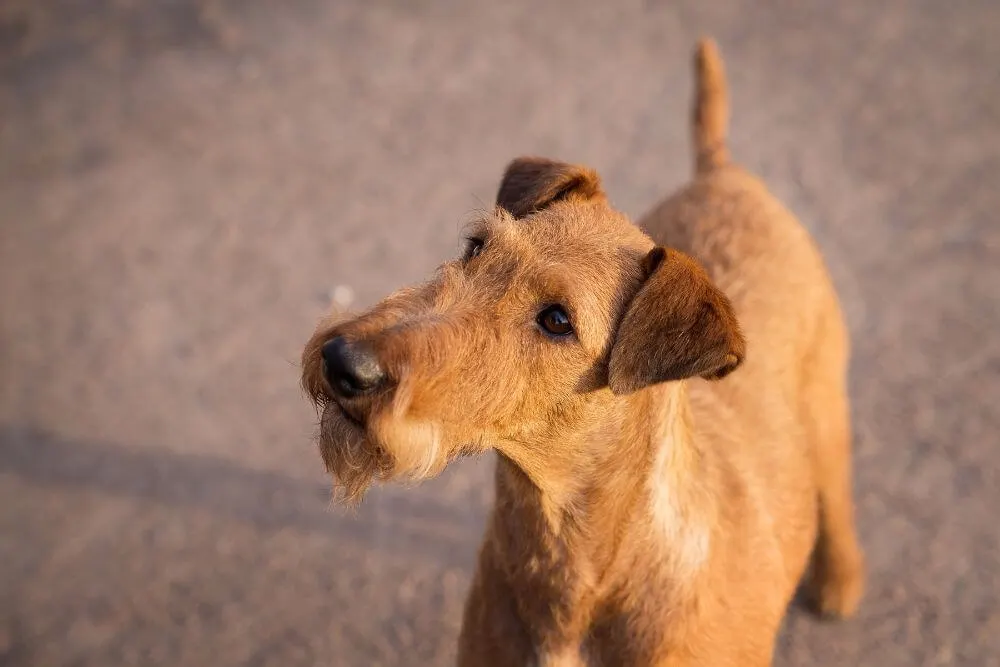
Irish Terriers are well loved pets, with a roguish character that has charmed the hearts of many. Once they are well trained, this fun loving dog makes a great pet and is likely to be a welcomed addition to a loving family.
The Irish Terrier may not be the most popular, it still ranked at 124 of 199 dogs in the American Kennel Club annual rankings in 2021.
While the number of Irish Terrier fans may not be particularly high, they are very devoted to this dog breed. There are a wide range of Irish Terrier gifts, as well as Irish Terrier ornaments available on the market catering to their tastes.
Did you know? Even as recently as 2022, an Irish Terrier became a New York Champion!
Native Irish Dog Breeds
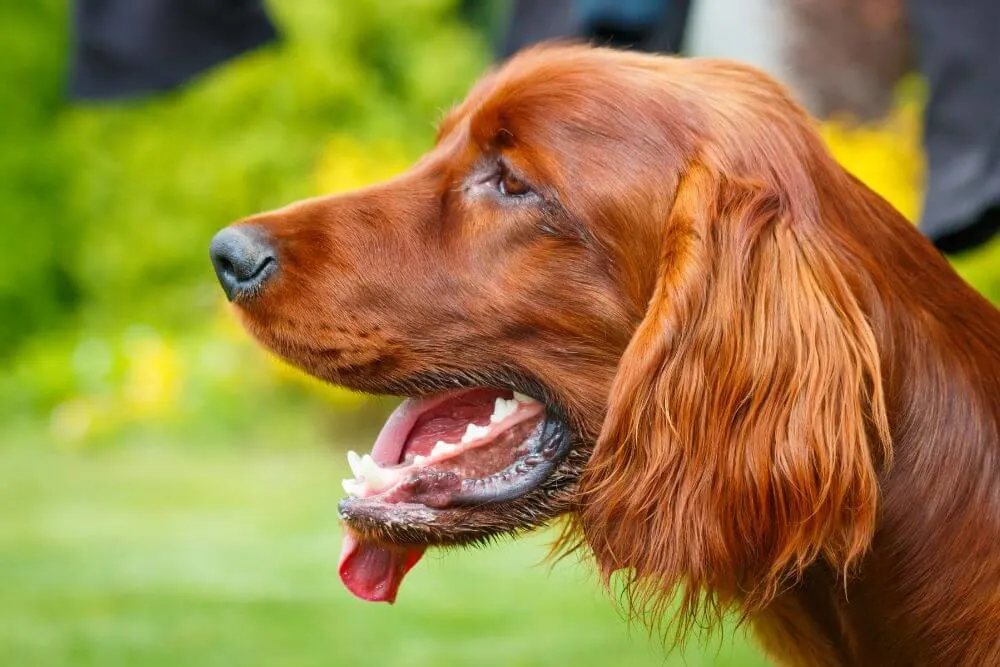
There are 8 other fascinating Irish dog breeds including:
- Irish Wolfhound
- Kerry Beagle
- Irish Setter
- Irish Red and White Setter
- Irish Water Spaniel
- Kerry Blue Terrier
- Irish Glen of Imaal Terrier
- Irish Soft Coated Wheaten Terrier (or Irish Wheaten Terrier)
Don’t be surprised if you see Irish written in front of a few more breeds such as the Irish Jack Russell, Irish Fox Terrier, Irish Staffordshire Bull Terrier, Irish Bull Terrier, Irish Wolf Terrier and Irish Wolfhound Terrier.
There are only 9 officially recognized Irish Dog Breeds. Breed Characteristics, history and facts about these native Irish dogs breeds are found in our guide.
There is also another dog that has strong Irish roots, that is the Irish Doodle. This dog is a cross between an Irish Setter and poodle mix.
Bonus Tip: Check out The Curious History of Irish Dogs by David Blake Knox for more insights into these Irish breeds!
You must be a dog lover if you have read allthe way to the end of this long article. Perhaps you are also interested in cats? We have some fitting Irish names for feline friends too!
Please note that this article is only for general information purposes about the Irish Terrier breed and should not be used as a substitute for health, medical and pet care advice from veterinary specialists.

(Irish Nature Expert and Celtic Enthusiast from Ireland)
Emer Walker, founder of LetsGoIreland.com, is a Cork native with profound expertise in Irish nature and ecology. Holding a PhD in Restoration Ecology and backed by extensive research in ecological sciences, she’s delved deep into Ireland’s natural wonders, from its rugged landscapes to its serene beaches. Emer’s passion also encompasses Celtic art and traditions. As a true authority on Ireland’s natural and cultural heritage, she invites readers through LetsGoIreland.com to immerse themselves in the authentic Irish experience.
